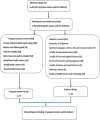Molecular characteristics of hepatitis B virus among students and pregnant women in Chad
- PMID: 40597040
- PMCID: PMC12219945
- DOI: 10.1186/s12879-025-11226-5
Molecular characteristics of hepatitis B virus among students and pregnant women in Chad
Abstract
Background: Hepatitis B virus (HBV) infection remains a global public health problem claiming about 1, 1 million lives among the several hundred million people infected with the virus globally. However, low- and middle-income countries including those in sub-Saharan Africa carry the highest burden but limited knowledge of the pathogen. This calls for studies to characterise the circulating genotypes of the virus in Sub-Saharan Africa. This study, sought to determine the molecular characteristics of HBV circulating among pregnant women and students in Chad.
Methods: Venous blood samples were collected from pregnant women and students in the capital of Chad between April and August 2021. Whole blood samples were spun at 2500xg at 4 °C for 10 min to separate the cellular parts from the sera. The resulting sera were tested for Hepatitis B surface antigen (HBsAg) using enzyme-linked immunosorbent assay (ELISA). HBsAg positivity was confirmed using the Abbott Architect i1000SR analyser. HBV-DNA viral load detection was performed for HBsAg positive sera. HBV-DNA viral load was determined in HBsAg positive sera samples. The S gene was amplified by nested PCR followed by visualisation of the resulting amplicons under UV transillumination after gel electrophoresis. The amplicons were sequenced using the Sanger technique and subjected to phylogenetic and mutational analyses.
Results: A total of 101 HBsAg-positive participants (recruited among students and pregnant women) were included in the study. The mean age was 25 years and 51.49% were males. Viral load was measured in 53 participants, among whom 27 (50.94%) had a viremia higher than 2000 IU/ml. The constructed phylogeny using 31 samples based of the HBV S gene showed that all strains belonged to the E genotype and evolutionary related to HBV from Cameroon, Central African Republic, Burkina Faso, Sudan and Ghana. The comparative mutational analysis identified low intragroup genetic diversity (0.004%) between Chadian strains with only two loci (codon positions 126 and 141) having nonsynonymous mutations including (Y126H, Y126N, Y126C, L140I, Y141S, Y141R, Y141H, Y141F).
Conclusions: The study shows the presence and circulation of HBV genotype E in Chad. The Chadian strains, compared to other genotype E strains from surrounding countries have very low genetic variability. The presence of immune escape mutations in the HBV S gene could be responsible for escape vaccine strains and thus reduce the efficacy of vaccination. Additionally, the presence of the transmembrane domain in the HBV S gene could alter the antigenicity of HBsAg, contributing to screening failure by standard tests (HBsAg negative despite active infection) or reduce the efficacy of drugs that target HBsAg. These results highlight the need to evaluate hepatitis B vaccination coverage and efficiency in Chad.
Keywords: Africa; Chad; Genotype; Hepatitis B virus; Pregnant women; Students.
© 2025. The Author(s).
Conflict of interest statement
Declarations. Ethics approval and consent to participate: The study with its protocols were reviewed and approved by the National Bioethics Committee of Chad (N˚ 201/PR/MESRI/DG/CNBT/2020, 8 November 2020) and the UCAD Research Ethics Committee (CER/UCAD/AD/MSN/050/2020, 7 December 2021). Following an explanation of the study in language understood by participants, an informed consent was obtained from participants before inclusion in the study. All procedures of the study were performed in accordance with relevant guidelines and regulations guided by the ethically approved protocols. Consent for publication: Not applicable. Competing interests: The authors declare no competing interests.
Figures





References
-
- WHO sounds alarm on viral hepatitis infections claiming 3500 lives each day. Available from: https://www.who.int/news/item/09-04-2024-who-sounds-alarm-on-viral-hepat.... Cited 14 March 2025.
-
- Combating hepatitis B and C to reach elimination by 2030. Available from: https://www.who.int/publications/i/item/combating-hepatitis-b-and-c-to-r.... Cited 22 Apr 2025.
MeSH terms
Substances
LinkOut - more resources
Full Text Sources
Medical
Miscellaneous

